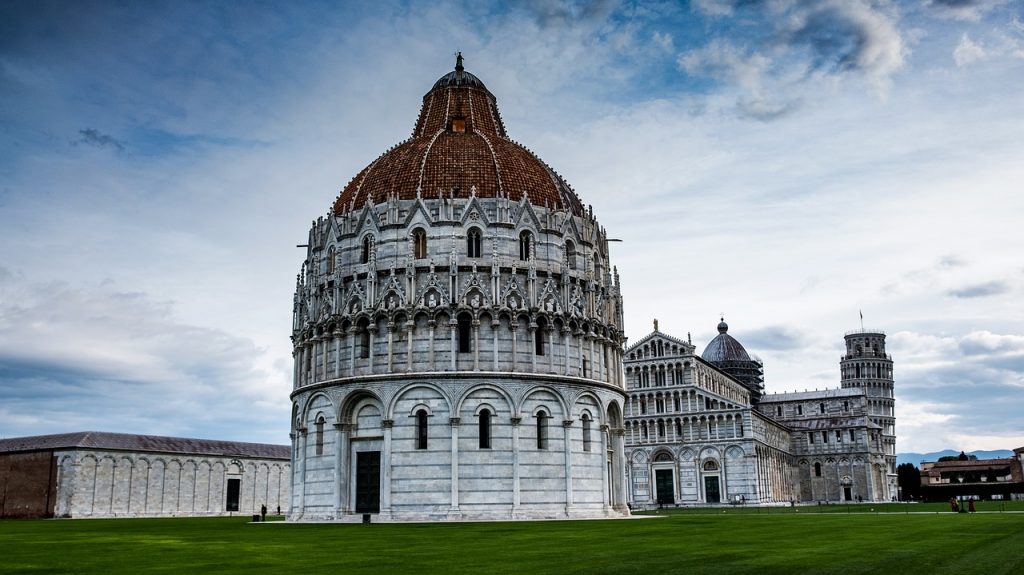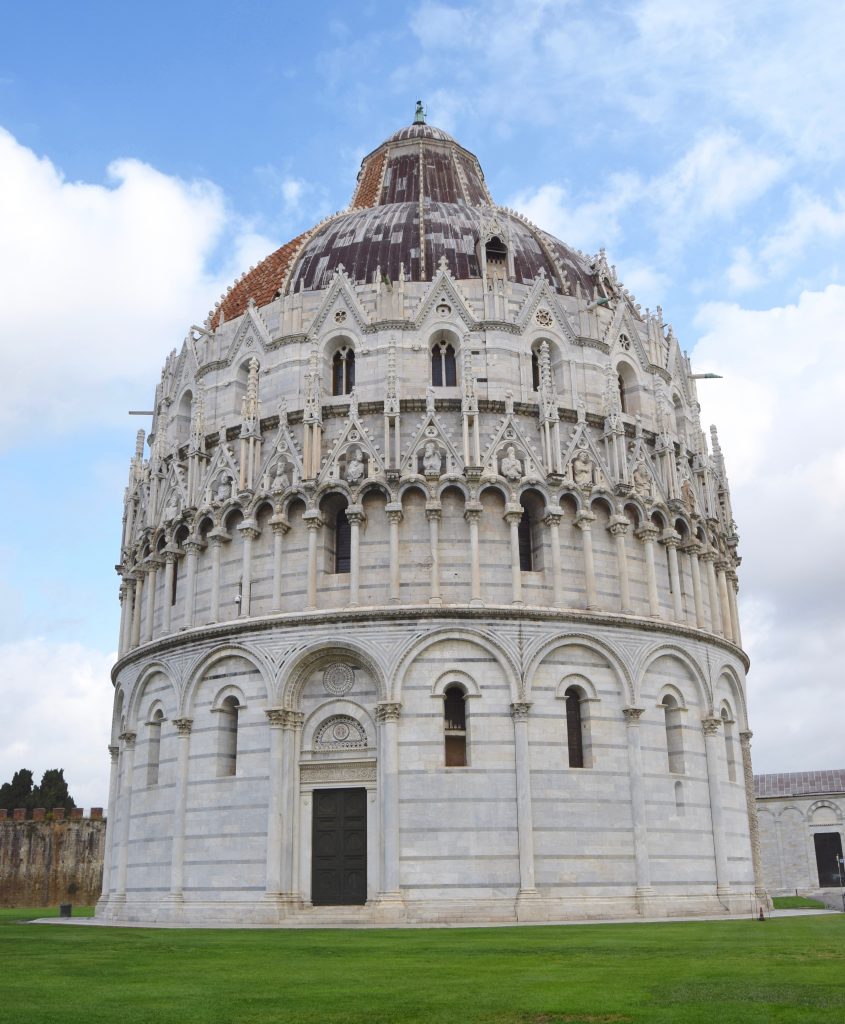Pisa Baptistery stands proudly in the Square of Miracles, sharing the piazza with its more famous brother, the Leaning Tower.
But this splendid example of Pisan Romanesque and Gothic style has its own share of wonders. Here we explore some of the top facts and curiosities that make it such a fascinating place to visit.
⇒ Top attractions and sights in Pisa
⇒ Pisa Travel Guide: What to see & do in Pisa

Pisa Baptistry – 10 incredible facts you need to know
1. ITS IMPRESSIVE SIZE
The round shaped Baptistery of Pisa welcomes visitors who enter Piazza dei Miracoli from the Porta Nuova, the ‘new’ gate opened by the Medici in 1562. This marble giant is almost as tall as the ‘queen’ of the piazza, the Leaning tower. It is in fact the largest baptistery in Italy standing at 55 meters and with a circumference of more than 100 meters. To put this into perspective it would take at least 50 people to embrace it.
=> 8 Must-see Places in Tuscany for first timers!
2. IT WAS BUILT BEFORE THE TOWER
The cathedral complex’s building site opened in 1063. The Cathedral was built first, after which work was started on the Baptistery (1153) – a worthy addition to what was then the biggest cathedral in Europe. Twenty years later it was the bell tower’s turn. This architectural phenomenon was Pisa’s business card. A way to show the world how powerful and wealthy the city was.
3. A TOUCH OF THE ORIENT
As with the Cathedral, some of its architectural elements like the arches that decorate its exterior, recall the style of oriental buildings. And it’s easy to explain why. Pisa, a powerful Maritime Republic at the time, had a strong bond with the the Islamic world, as its invincible fleet was fighting the Saracens and trying to dominate commercial trade routes in the Mediterranean. But it wasn’t all hostility. Pisa was busy doing business with the ports in North Africa, establishing its presence with commercial contracts, so that together with exotic goods, plenty of artistic ideas used to travel back to the Tuscan city.

4. THE BAPTISTERY TILTS LIKE THE TOWER
Many buildings in Pisa tilt, and so does its grand Baptistery. Though it’s not very noticeable – it does in fact tilt 0,6 degrees towards the cathedral. The reason this happens is because the soil in Pisa is rich in sand and clay, and architects have been struggling with the Leaning Tower’s visually appealing ‘defect’ since the early stages of its construction.
5. DEDICATED TO SAINT JOHN THE BAPTIST
The full name of the cathedral is “Battistero di San Giovanni” and as you can guess, it’s perhaps not that surprising that it’s dedicated to John the Baptist. The main portal faces the Cathedral, a fact which has symbolic importance. It’s from this door that people would access the church after being baptised and purified of their original sin. It also has the most impressive decoration, and on the lintels are carved stories from the life of Saint John.
6. FAMOUS ARTISTS MAKE THEIR MARK
The architect who designed the Baptistery was Diotisalvi, but the famous father and son who left their mark on the buildings set in this square are Nicola and Giovanni Pisano. The Pisano family have gone down in the history of art as the revolutionary sculptors whose style shifted from the static Gothic to a more naturalistic style, that would eventually lead to the Renaissance. They added the Baptistery’s upper part and the dome, that was completed in 1363, two century after the first stone was put down.
Are you an art passionate? Find out about the Top Renaissance masterpieces in Florence.
=> 8 Famous Statues in Florence you absolutely have to see!
7. PULPIT BY NICOLA PISANO
The marble pulpit (1257-60) is the artistic highlight of Pisa Baptistery, a work that represents the transition between late Gothic and Early renaissance. Nicola Pisano was clearly following the example of the classic when creating his scenes. He used an early drill to give depth to his figures, and the famous scene of the nativity depicts Mary in different stages, from the annunciation to the Baby Jesus’s first bath, with details and realistic poses. He opened a new path to realistic representation that his son Giovanni would follow, setting an example for many artists to come.
♥ Discover all the reasons why you should visit Pisa!

8. BAPTISMAL FONT
In the centre you find a big octagonal font, the work of a northern artist Guido Bigarelli. In the Middle Ages baptism was done by immersion, so the font needed to be able to contain a person. The word ‘baptism’ comes in fact from the Greek “immersion”.
9. CLIMB TO THE UPPER LEVEL
To get an unusual perspective of the Piazza dei Miracoli and some awesome pictures we recommend you climb to the viewing level. Grab your camera and prepare to be impressed.
10. ECHO MAGIC IN PISA BAPTISTRY
Pisa Baptistery is famous for its acoustics, that’s why every half an hour a guardian comes in to intonate a few notes that shows just how well the sound resonates around the space.
⇒ If you’re planning a visit to Pisa, Italy, follow our itinerary for the perfect day in Pisa.
=> Discover why the Competition Panel by Ghiberti and Brunelleschi for Florence Baptistry mark a pivotal moment in art history.

